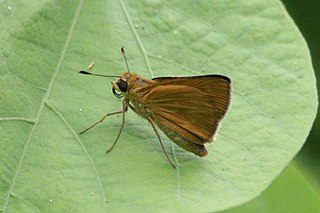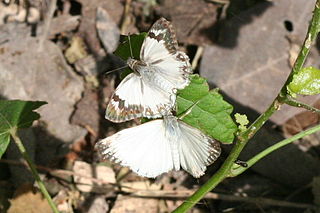
Eantis mithridates, also known as the sickle-winged skipper or Jung's dusky wing, is a species of butterfly in the family Hesperiidae. It is found from Argentina, north through tropical America and the West Indies to southern Texas. A regular stray north to central Texas, rarely to Arkansas and Kansas.

Lerodea eufala, the Eufala skipper or rice leaffolder, is a species of butterfly in the family Hesperiidae. It is found from the coast of Georgia, south through Florida and west across the southern United States to southern California, south through Mexico and Central America to Patagonia. In the summer, it expands its range north to central California, North Dakota, southern Wisconsin, northern Michigan and Washington, D.C.

Nastra julia, the Julia's skipper, is a species of butterfly in the family Hesperiidae. It is found in North America from southern Texas to central Mexico.

Anthanassa frisia, the Cuban crescentspot, Cuban checkerspot or Cuban crescent, is a butterfly of the family Nymphalidae. Subspecies tulcis is known by the common names pale-banded crescent or Tulcis crescent; it is treated as a species by some authors.

Zizula cyna, the cyna blue, is a butterfly species in the family Lycaenidae.

Calpodes ethlius, the Brazilian skipper, larger canna leafroller or canna skipper, is a butterfly of the family Hesperiidae. It is found in the United States from southern Florida and southern Texas, south through the West Indies, Mexico, and Central America to Argentina. Strays and temporary colonies can be found north to southern Nevada, northern Texas, Illinois and Massachusetts.

Wallengrenia egeremet, the northern broken dash , is a butterfly of the family Hesperiidae. It is found in North America from southern Maine and southern Ontario, west across the Great Lakes states to southeastern North Dakota, south to central Florida, the Gulf Coast and south-eastern Texas.

Wallengrenia otho, the southern broken dash or broken dash skipper, is a butterfly of the family Hesperiidae. It was originally described by Smith in 1797. It is found from eastern Texas and the southeastern United States, south through the West Indies and Central America to Argentina. Strays can be found as far north as central Missouri, northern Kentucky and Delaware.

Texola elada, the Elada checkerspot, is a species of butterfly in the brush-footed butterfly family, Nymphalidae. It is found from southern Mexico north to central Texas and central Arizona in the United States.

Phocides polybius, the bloody spot or guava skipper, is a species of butterfly in the skipper family, Hesperiidae, that is native to the Americas. It is found from the lower Rio Grande Valley of southern Texas in the United States south through Mexico and Central America to Argentina. The species was first described by Johan Christian Fabricius in 1793.

Cecropterus dorantes, the lilac-banded longtail or Dorantes longtail, is a species of butterfly in the family Hesperiidae. It is found from Argentina, north through Central America, Mexico, and the West Indies to southern Texas and peninsular Florida. Strays can be found as far north as northern California, southern Arizona, southern Missouri and North Carolina.

Chiothion asychis, the white-patched skipper or white patch, is a species of butterfly in the family Hesperiidae. It is found from Argentina, north through tropical America to the West Indies and southern Texas. Strays can be found as far north as southern Arizona, Nevada and Kansas.

Heliopetes macaira, the Turk's-cap white-skipper , is a butterfly of the family Hesperiidae. It is found from southern Texas in North America, south through Central America to Paraguay.

Celotes nessus, the common streaky-skipper, is a butterfly of the family Hesperiidae. It is found in North America from southern Arizona, southern New Mexico, and western Texas south to northern Mexico. Rare strays can be found up to southern Oklahoma and northern Louisiana.

Pyrisitia nise, the mimosa yellow, is a butterfly in the family Pieridae. It is found from Argentina north to the Texas Gulf Coast and throughout central and southern Florida, northward to the Tennessee Valley. It is an occasional stray to central Texas and south-eastern Arizona and rarely to southern California, southern Colorado and Kansas. The habitat consists of brushy woodland edges.

Phoebis agarithe, the large orange sulphur, is a butterfly in the family Pieridae. It is found from Peru north to southern Texas and peninsular Florida. Rare strays can be found up to Colorado, South Dakota, Wisconsin, and New Jersey. The species has also been introduced in Hawaii. The habitat consists of open, tropical lowlands including gardens, pastures, road edges, trails and parks.

Mestra is a genus of nymphalid butterfly. It contains the single species Mestra dorcas, the Jamaican mestra, which is found from southern North America to South America and possibly Mestra cana, the St Lucia mestra, found in the Lesser Antilles.

Rekoa marius, the Marius hairstreak, is a butterfly in the family Lycaenidae. It is found from Paraguay north to Sonora in Mexico. Strays may be found as far north as southern Texas. The species used to be considered rare in the southern Texas. It is the species of Rekoa found in Arizona. The habitat consists of disturbed tropical areas.

Anthanassa texana, the Texan crescentspot, is a species of butterfly in the family Nymphalidae. It is found from Guatemala north through Mexico to southern California, east across the southern United States to northern Florida, Georgia and South Carolina. Strays may be found up to Arkansas, Missouri, Illinois, South Dakota, and central Nevada. The habitat consists of deserts, dry gulches, open areas, streamsides, road edges, and city parks.

Strymon albata, the white hairstreak, is a butterfly of the family Lycaenidae. It was described by Cajetan Felder and Rudolf Felder in 1865. It is found from southern Texas to Costa Rica, Colombia, Venezuela and Trinidad.




















